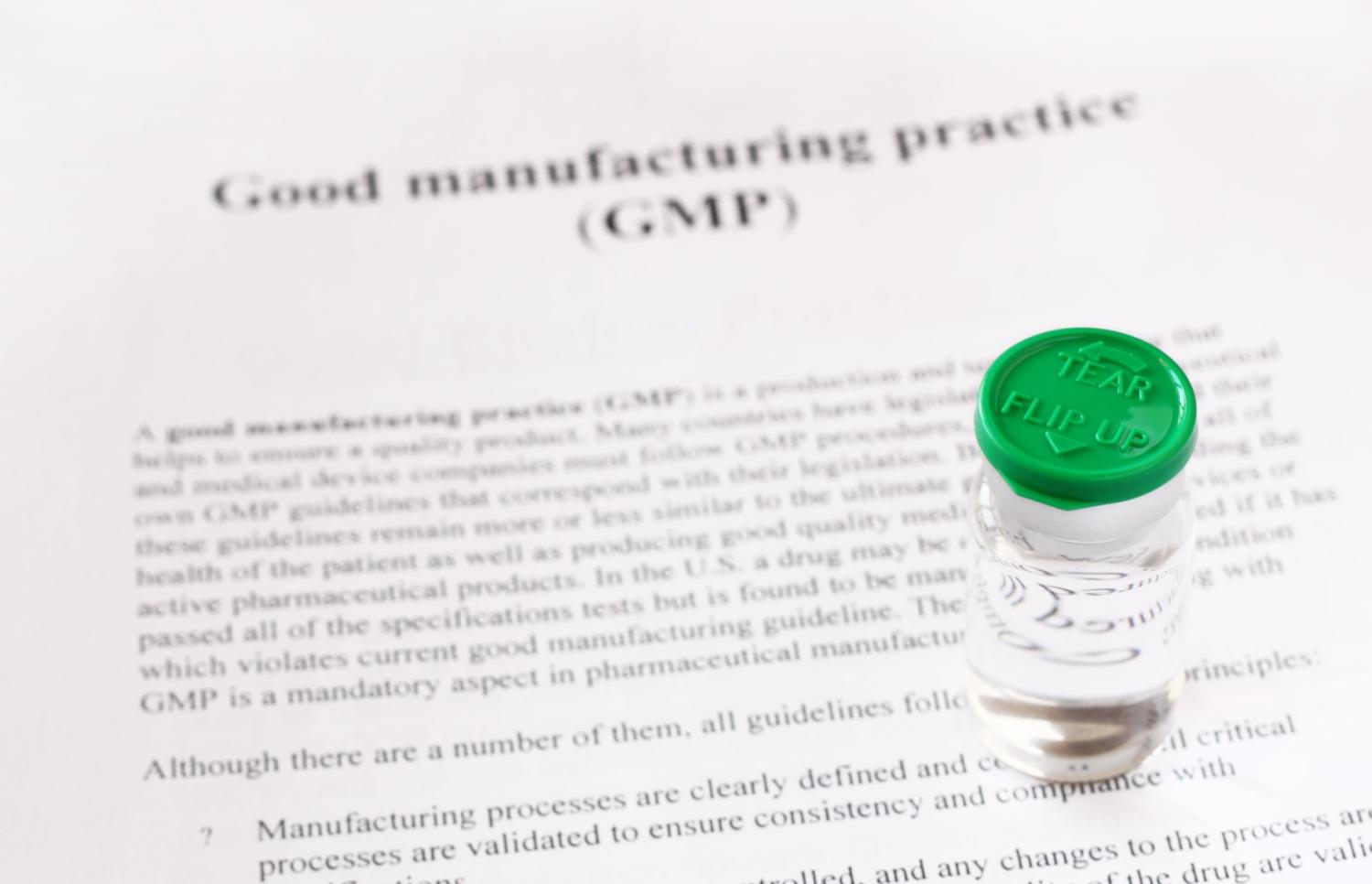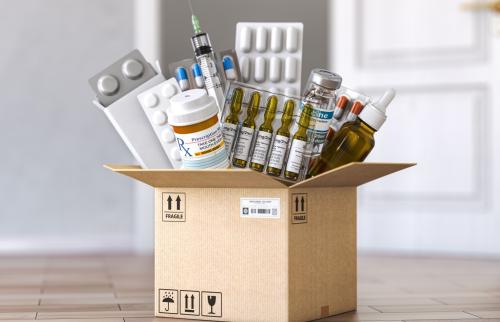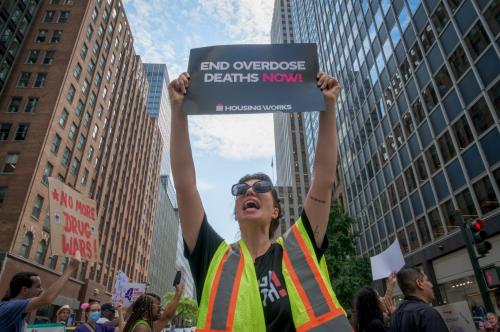Introduction
Modern medicine depends on a guarantee we often take for granted: that the drugs we swallow, apply, or inject work as intended. By law, it is drug manufacturers who bear the primary responsibility for making sure each product meets quality standards. The role of the Food and Drug Administration (FDA) is to ensure manufacturers comply with these requirements, but as supply chains expand across the globe, this role has become harder to carry out.
To ensure consistent drug quality, FDA relies on a combination of prescriptive regulatory requirements, facility inspections, and various compliance tools. FDA requires manufacturers to have strong quality systems that follow Current Good Manufacturing Practices (CGMP), including oversight of every production step, checking samples during production, and keeping thorough records. FDA investigators then verify compliance with standards through both scheduled and unannounced inspections, during which they review everything from personnel training and equipment maintenance to contamination control and recordkeeping. When serious violations are uncovered, FDA can act through warning letters, drug recalls, import refusals, import alerts, and injunctions.
But the FDA oversight system is imperfect. FDA struggles with persistent staffing shortages and inspection backlogs, especially for foreign facilities in countries like India and China. Many inspections abroad are still announced in advance, which weakens detection of compliance issues. Driven by economic forces, pharmaceutical manufacturers of low-cost generics often have weak quality management systems and quality assurance units that lack the authority and resources to enforce CGMP compliance effectively. FDA’s “too important to fail problem”—where FDA will allow noncompliant facilities to continue shipping medically necessary drugs if there is shortage risk—only reinforces those weaknesses.
Proposals to address these shortcomings primarily focus on supporting FDA through expanding unannounced inspections, increasing inspection frequency, improving policies to ensure inspector independence, addressing inspection workforce and backlog challenges, and exploring alternative monitoring tools, such as remote access to documents, information from inspections conducted by foreign regulators not part of mutual recognition agreements, or third-party audits.
In this paper, I propose an alternative but complementary path to enhance U.S. drug quality assurance by requiring every importer to designate a qualified individual—located in the U.S.—who certifies that each batch meets Good Manufacturing Practices (GMP) standards after assessing the firm’s compliance, including through additional testing of product. This framework—already established in Europe for drugs and to some extent in the U.S. for certain food imports—raises accountability and increases oversight by adding a second, importer-level layer of verification beyond the manufacturer.
To motivate the proposal, this paper first examines how the U.S. and European systems differ in their approach to manufacturing quality compliance, including through batch release procedures, finished product testing, and facility inspections. It then reviews FDA’s Foreign Supplier Verification Program, authorized under the Food Safety Modernization Act of 2011. Next, the paper explores the benefits of adapting the “Qualified Person” and import testing systems within the U.S. drug quality oversight system—not as a replacement, but to strengthen the existing regulatory framework. Finally, the paper discusses various considerations for implementing these changes.
Approach to accountability
International GMP standards require that drug manufacturers conduct a thorough review of all production, packaging, and testing records to confirm compliance with documented procedures and quality standards, with formal approval carried out by qualified personnel before any batch is released for distribution.
To comply with GMP standards, both FDA and EU legislation mandate that manufacturers maintain an independent department—called the ‘Quality Unit’ under FDA regulations and ‘Quality Control’ (QC) in the EU—responsible for approving or rejecting materials and products, reviewing production and quality records, investigating discrepancies, ensuring controls and procedures are followed, and maintaining the overall pharmaceutical quality system.
But the degree and nature of accountability differ substantially between the FDA and EU models.
In the EU system, the importer must designate a Qualified Person (QP)—a specific individual who holds personal responsibility to certify that each batch released for sale meets GMPs, the product’s marketing authorization (the EU equivalent of FDA drug approval), and all applicable EU laws. However, a QP is not simply appointed by the importer; the individual must have specialized academic degrees, relevant industry experience, and must be formally recognized and approved by the relevant national regulatory agency before they may take on the role. The QP’s professional qualifications, certification requirements, and responsibilities—including the non-delegable duty for batch certification—are fully detailed in EU law and accompanying guidance, particularly EudraLex Volume 4, Annex 16.
Because the QP operates in addition to, not instead of, the manufacturer’s QC, release of an imported batch involves two steps. First, the exporting manufacturer’s internal QC department authorizes shipping from the foreign production site to the EU importer. Second, the EU-based QP ensures that the batch is re-tested in the EU and then certifies that the batch was manufactured in accordance with EU GMP and in accordance with the EU marketing authorization. Only following the QP certification may the batch be released into distribution.
To fulfill their responsibilities, QPs review quality documentation provided by the manufacturer’s quality control or third-party laboratories. QPs have limited discretion to certify batches exhibiting minor deviations—those deviations that do not affect product quality, safety, or efficacy—but only after conducting a thorough, documented risk assessment. Batches with major deviations or out-of-specification results that could potentially impact product quality or patient safety must not be certified.
QPs can delegate to trained personnel some of the checks necessary for the review, but they cannot delegate their sign-off responsibility.
QPs may face personal liability if they negligently certify defective products that cause harm. QPs must be EU residents, putting their QP accountability within the EU importer’s jurisdiction.
QPs may join, or in some cases are required to join, national or international professional associations dedicated to supporting QPs. These organizations, such as the European Qualified Person Association (EQPA), provide platforms for ongoing education, facilitate the exchange of best practices, and promote harmonization of standards across the region. Membership can offer access to policy updates, professional discussion forums, and regular meetings or seminars to address emerging challenges in pharmaceutical quality assurance. Depending on the country, association membership may be a formal prerequisite for QP registration or may simply be encouraged as a valuable resource for professional development and networking within the highly regulated environment of drug manufacturing oversight.
Approach to testing
Both the U.S. and EU regulatory systems require that drug manufacturers comply with GMPs, which in turn means that manufacturers must perform in-process and final product sampling using official pharmacopeial methods—the US Pharmacopeia (USP) in the United States and the European Pharmacopoeia in the EU. In both jurisdictions, manufacturers can do their testing in-house or can contract it out to analytical labs. Contract laboratories are considered part of the manufacturing process and must be registered with regulators and subject to GMP inspections.
However, the U.S. and European regulations differ in how they approach product testing beyond the GMP-mandated analyses performed by or on behalf of manufacturers.
In the United States, FDA does not mandate testing beyond what is required for the manufacturers’ Quality Units at the site of manufacture as part of standard CGMP procedures, It may, however, require additional testing as part of enforcement actions, such as a consent decree or a warning letter. In such cases, FDA may require the manufacturer to utilize an external laboratory to perform supplemental CGMP-compliant analyses. The FDA also operates its own drug testing laboratories; however, these activities are limited in scope and volume, focusing primarily on risk-based sampling of products that are linked to safety signals or identified quality concerns.
By contrast, each batch of drugs imported into the EU must be tested again within the EU before it can be released for distribution, except when medicine is imported from countries that have a Mutual Recognition Agreement (MRA) with the EU. This exemption means that drugs manufactured in the U.S., Canada, Australia, or Switzerland are not required to undergo this additional testing, but drugs coming from India and China are. The responsibilities and requirements for batch importation testing—applicable to commercial and investigational medicinal products—are comprehensively detailed in EU law and applicable guidance, specifically EudraLex Volume 4, Annex 21 (“Importation of medicinal products”).
For imports from countries without an MRA, batch release testing must be conducted within the EU. The product batches, not just the samples, generally physically arrive in the EU before the testing is performed, as EU regulations require testing on samples representative of the actual imported batch, including shipping conditions. The importer may use an in-house EU-based laboratory for testing, or they may contract an EU-based GMP-compliant lab. Import testing in the EU is part of manufacturing, and laboratories are required to be registered and undergo GMP inspections.
The importer’s QP then uses lab reports along with other relevant information to determine whether certifying each batch for release is appropriate.
Approach to inspections
Both FDA and EU national authorities conduct inspections to ensure manufacturing facilities comply with GMPs. Common elements include a detailed review of manufacturing processes, quality systems, documentation, and personnel training, supported by risk-based site prioritization to focus resources effectively. Because the FDA and EU national authorities have similar standards and approaches, the respective regulators have signed Mutual Recognition Agreements, which allow the respective regulators to rely on the other’s GMP inspections.
The differences that do exist are perhaps more nuanced. While FDA follows a more prescriptive, audit-focused approach based on detailed CGMP regulations, with C indicating the current version of GMPs, the EU employs a principle-based GMP framework. FDA inspections typically culminate in the issuance of a Form 483 listing specific observations, which do not distinguish between their importance and, for some of them, require documented corrective actions. In contrast, EU inspections, generally conducted by national competent authorities with EMA coordination for sites located in third countries, end with a verbal or formal inspection report that classifies deficiencies by severity (critical, major, or other and requires documented corrective actions).
Food importers example
The concept of a qualified person is familiar to FDA through the Foreign Supplier Verification Program (FSVP), established under the Food Safety Modernization Act (FSMA). Under FSVP, importers must verify that foreign suppliers meet U.S. safety standards and maintain adequate records of compliance.
FSVP was established in the aftermath of growing concerns about FDA’s ability to oversee a rapidly expanding and increasingly global food supply chain. Bioterrorism threats in the early 2000s, especially after 9/11, led the U.S. government to focus on the vulnerability of food imports to both unintentional contamination and intentional adulteration. A government working group that included FDA responded with its draft “good importer practices” guidance, shifting part of the oversight burden from border inspection to importers themselves through systematic, risk-based verification of foreign suppliers. Multiple foodborne illness outbreaks traced to imports reinforced these concerns, and Congress codified these measures into FSMA by creating FSVP.
Just as in the EU drug QP system, FSVP requires a qualified individual—in this case, the U.S. food importer or their designated agent—to implement preventive controls ensuring the safety and integrity of imported food products. The FSVP importer is defined as the U.S. owner or consignee of the food (or, if none exists, the U.S. agent for the foreign supplier), making compliance a matter of legal responsibility for the party with actual ownership or control. Depending on the food and its hazard profile, verification may include supplier audits, record reviews, or sampling and testing.
Both the EU QP system and FDA’s FSVP use the MRA concept with countries that have comparable regulatory standards and oversight (under FSVP, the agreements are called system recognition agreements). Based on this shared trust, the EU waives batch retesting for drug imports from recognized partners. With FSVP, the requirements for food importers from recognized countries are not eliminated but reduced, meaning importers face fewer or less frequent verification steps.
FSVP also does not go as far as the EU QP system in concentrating accountability or in testing. In FSVP, responsibility for compliance rests with the importer, not a particular individual. FSVP also does not require routine batch-by-batch testing of imported food. Instead, U.S. importers must conduct risk-based supplier verification, which can include periodic testing when justified by food or supplier risk.
The QP-testing proposal
Adopting elements of the EU’s QP system along with mandatory import testing would require statutory changes to the Federal Food, Drug, and Cosmetic Act. Given how difficult it can be to pass such legislation, it is appropriate to ask whether this QP-testing proposal would provide sufficient benefits to warrant legislative action.
The effectiveness of enforcement systems like FDA’s manufacturing oversight depends on a combination of enforcement practices, incentive structures, and meaningful consequences for non-compliance. Assessing proposals by how they shift this balance helps clarify where the QP-testing approach would bring differences compared to the status quo.
The current manufacturing oversight system leaves notable gaps in incentive structure and accountability. Drug facility inspections are relatively infrequent, particularly for foreign sites, which often have advance notice of upcoming FDA visits. Violations typically result in corrective action plans rather than immediate exclusion from the market. When shortages threaten drug availability, FDA may deliberately temper enforcement by allowing non-compliant facilities to continue production and, in some cases, permitting substandard products to be distributed under additional safety measures. Executives authorizing cost-saving decisions that compromise quality rarely face personal accountability.
Layering a QP system onto FDA’s existing system would change both the probability of problems being detected and the consequences once they are uncovered. Detection probability would increase through required import testing and the additional review conducted by QPs, whether through documentation checks or site audits. Consequences would increase because—in addition to the legal responsibility of the firm—the QP would now be personally responsible for certifying each batch and, therefore, unwilling to approve products whose CGMP compliance is in doubt. Conversations with current and past QPs confirm that dynamic.
But this begs another question—why would anyone sign up to be a QP, especially in the more litigious U.S. environment?
The answer lies in how market access and professional accountability interact, and in how regulatory design actively counters the QP’s inherent conflict of interest: QPs are paid by the importer but must maintain strict independence. In the European system, no batch can reach patients without a QP’s certification, and the QP personally carries legal liability for that decision. This dual requirement creates an equilibrium: companies must secure QPs and offer the authority and independence needed to fulfill their responsibilities. Without such assurances, a QP would simply refuse to certify batches, leaving the company unable to sell.
Over time, the scarcity and indispensability of QPs reinforce their leverage and professional stature. High turnover of QPs would severely disrupt supply and attract regulatory scrutiny, which further incentivizes companies to retain and support these professionals.
In this way, the QP role functions much like other licensed professions that carry statutory responsibilities—auditors in securities law, licensed engineers in public safety, or clinical investigators in research ethics. Each operates under personal accountability, but within an institutional framework that balances responsibility with protections against unreasonable liability.
Nonetheless, translating the European QP system into the U.S. context might require attention to liability. While a certain degree of individual responsibility is essential to make the role effective, unlimited personal exposure could discourage qualified professionals from serving as QPs. To avoid deterring qualified personnel, legislation could define the scope of liability in ways that preserve accountability but prevent excessive or disproportionate personal exposure—for example, recognizing good‑faith judgments and reasonable effort.
One other way that liability exposure can be managed is through the development of QP professional societies discussed earlier. Through their educational efforts, such societies can help QPs lower the risk of inadvertent errors. In cases where liability concerns do arise, the associations also offer access to expert legal counsel and support to help members respond appropriately to investigations or regulatory actions, ensuring their interests are represented within the bounds of professional responsibility.
Design and implementation
Effective implementation of a QP system and enhanced import batch testing hinges on addressing several design and implementation issues: designing the QP system, scoping the batch testing requirement, resolving policy obstacles related to payment, and determining appropriate phasing to safeguard drug supply. The following Q&A provides direction in these areas.
-
Q: How should the QP system be designed?
One important design choice for a U.S. QP system is its coverage—specifically, which manufacturing facilities must comply. In the EU, the QP requirement is applied universally to all facilities, ensuring consistency across domestic production and imports. In the U.S., policymakers could choose to apply the QP system only to drugs imported from facilities in non-MRA countries. This more targeted approach would supplement FDA oversight where inspection reach is most limited and help level the playing field between foreign and domestic sites. Implementing it would require redefining the role of FDA MRAs, which currently address only inspection recognition, not batch certification or broad market access.
Another design choice is whether U.S. QPs should be certified by FDA—a departure from FDA’s current role, which involves inspecting facilities and approving products, but not certifying individuals. Where FDA does require individuals with specified competencies—for example, the FSVP Qualified Individual or Preventive Controls Qualified Individual—compliance is assessed by reviewing training and experience during inspections, rather than through direct licensing. Adopting a formal QP certification system would represent a significant shift, introducing new administrative demands and costs for regulators and industry.
Although requiring formal FDA certification would be a shift, certification itself offers important advantages. If batch release is tied to market access, revoking a QP’s credentials would have immediate consequences—not just for the individual, but for the firm as well. This structure creates clear accountability and makes compliance matter to both parties.
Notably, FDA would not need to serve as the credentialing body to achieve this accountability. FDA could establish standards and retain oversight, accrediting an independent organization with the demonstrated ability to administer certification. USP, whose compendial standards are incorporated into GMPs and enforced by FDA, would likely be well-positioned for this operational role.
-
Q: How should batch testing requirements be designed?
To adopt a requirement that every batch of imported drugs be tested before entering the U.S. market, Congress would need to resolve several policy design decisions: to whom should testing requirements apply, with what frequency should testing occur and where, and whether testing should be done by independent laboratories.
The first design decision is whether batch testing should apply only to imports originating in non‑MRA countries, as is done in the EU, or to all imports. In that context, it is helpful to consider the problem this proposal is trying to address, namely, challenges related to quality oversight in countries where FDA cannot rely on its regulatory counterparts to oversee manufacturing the way MRA regulatory counterparts can. This consideration supports the rationale for adopting MRA-based exemptions.
Another design decision is how frequently batch testing should occur—whether to require testing for every batch or to apply a risk-based approach. While universal batch testing may seem extensive, current U.S. oversight is already selective, so strengthening requirements would call for a more comprehensive approach that comes with batch testing. Because pharmaceutical batches are often large, the cost is spread across many units, reducing the per-dose impact. Still, more frequent testing would increase overall costs, especially for smaller batches.
The third design decision is whether to require batches to arrive in the U.S. before they are tested. In the EU, the product arrives before QP testing because the law requires that the test sample is representative of the batch, including the transport conditions that might affect the product integrity. This, however, significantly adds to the cost because the product awaiting QP certification would sit in U.S.-based warehouses rather than back in India. This presents a tradeoff for policymakers: greater cost versus greater assurance that the sampled product is representative of the batch.
The last design decision concerns whether testing should be performed only by independent third‑party laboratories or whether importer-owned labs could also qualify, as is allowed in the EU system, and as is allowed by FDA for Quantity Unit testing. Third‑party testing would strengthen independence and reduce conflicts of interest, while offering FDA a more centralized set of entities to audit.
But relying solely on third-party laboratories would introduce significant oversight challenges, as FDA would need to redirect inspection resources to audit many more of these facilities, necessitating additional resources and therefore funding. Congress could mitigate these risks by mandating a certification process for laboratories conducting batch tests, providing FDA with direct leverage to address performance issues. While such a system could enhance accountability and public confidence, it would also require substantial resources and could limit initial laboratory eligibility, thereby complicating broad adoption.
Ultimately, any approach—whether relying exclusively on third-party labs or integrating importer-owned facilities—should balance independence, regulatory oversight, and practical feasibility.
-
Q: This adds to the cost of production. Will prices rise?
Adopting a QP system and batch testing requirement for drug imports inevitably raises production costs, but the extent to which it does depends on the policy’s scope. In the EU, QP certification applies to all manufacturers and batch testing targets non-MRA imports. Since oversight gaps in non-MRA countries are the core rationale for this proposal, Congress could choose to limit requirements to those imports, exempting domestic and MRA-based manufacturers. As a result, the added costs would be concentrated on higher-risk products where FDA oversight is most limited.
Even within non-MRA countries, there can be substantial differences in CGMP compliance across facilities, be it because they are subsidiaries of U.S.-based or EU-based firms, or for other reasons. There are ways to design the system to further make it risk-based, without painting a broad non-MRA brush. For example, batch testing requirements could be lowered, without being eliminated, if unannounced inspections and prior testing show no issues. This would provide significant savings by eliminating warehouse costs in the U.S. as the samples are being tested. Regulators could also explore bundling batch sign-off under certain circumstances or starting with greater liability protections for QPs, ratcheting up the exposure if violations are found.
For products subject to new requirements, certification, compliance, and expanded testing would increase production costs and put upward pressure on prices, especially for drugs produced in smaller batches. But because many generic drugs are already inexpensive, even a sizable percentage increase results in only a modest absolute rise. For example, a 25% cost increase for top generic drugs—which, according to one analysis, often cost pharmacies less than $1.50 for a 30-day supply—would mean about 37 cents more per month. This seems like a relatively modest trade-off for enhanced reliability and quality assurance.
However, price increases in the U.S. reimbursement system face regulatory hurdles. Programs like Medicaid and 340B impose inflation rebates that prevent manufacturers from recouping higher costs tied to quality improvements. (Medicare also has inflation rebates, but it exempts almost all generics). These policies pose barriers not only for this proposal, but for supply chain reforms broadly—including Senate Finance Committee drug shortage proposals and China de-risking initiatives.
-
Q: What are key considerations for staging the QP-testing policy?
Managing industry incentives will determine the success of rolling out the QP system in the U.S. The policy’s core mechanism is straightforward: only drug batches tested by GMP-compliant laboratories and certified by a QP would be permitted entry to the market. However, excluding noncompliant imports carries the risk of creating drug shortages.
Industry stakeholders are aware that premature enforcement could cause supply disruptions and often use this as leverage to delay adoption by signaling potential shortages. This creates a perverse incentive for companies to slow progress, anticipating that FDA will postpone implementation deadlines to avoid worsening drug availability.
To address these challenges, FDA could incorporate QP certification and batch testing compliance into its risk-based site selection model for inspections. Firms demonstrating compliance would be classified as lower but not necessarily low risk, benefiting from reduced frequency and intrusiveness of traditional FDA inspections—a practical incentive for early adoption. Concurrently, Congress could mandate penalties—financial or import restrictions—for firms failing to meet QP and testing requirements by set deadlines. Making penalties proportional to units sold could fairly target those companies with the greatest influence in the U.S. drug supply.
Conclusion
FDA’s traditional approach to manufacturing quality oversight faces growing challenges. As the pharmaceutical supply chain expands globally and FDA resources remain stretched, it becomes increasingly difficult for the agency to detect and address quality lapses. When inspections are infrequent and penalties are limited, manufacturers may be incentivized to cut corners, increasing risk to quality. FDA’s practice of regulatory flexibility to avoid drug shortages—allowing noncompliant facilities to continue producing medically necessary drugs—reinforces the “too important to fail” dynamic, entrenching systemic vulnerabilities.
Many recent proposals understandably focus on increasing the probability of detecting problems through expanding inspection frequency, enabling unannounced visits, and improving enforcement resources, particularly overseas. There have also been calls for increased testing. But addressing accountability has received less attention, even though it is equally critical.
Introducing a QP system, complemented by mandatory import testing of every batch, provides a stronger safeguard for drug quality. By combining mandatory product testing of imports and batch certification from a qualified U.S.-based person who bears personal sign-off responsibility, the system enhances both detection and deterrence. Above all, it underscores that accountability for safeguarding drug quality and compliance rests squarely with the industry—not with regulators.
-
Acknowledgements and disclosures
This project was conducted with support from the Gary and Mary West Health Policy Center. I would like to thank Carlo de Notaristefani, Brandon Cuddy, Francesco Cea, Ilisa Bernstein, Michael Rogers, and Rachel Sachs for their valuable contributions and perspectives. I would also like to thank Rasa Siniakovas for her excellent research support.
The Brookings Institution is committed to quality, independence, and impact.
We are supported by a diverse array of funders. In line with our values and policies, each Brookings publication represents the sole views of its author(s).







